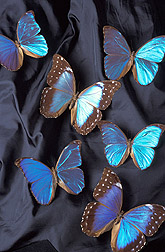This page has been archived and is being provided for reference purposes only. The page is no longer being updated, and therefore, links on the page may be invalid.
|
Read the magazine story to find out more. |
Bugs Behind the Scenes at Natural History MuseumBy Luis PonsJune 10, 2002 Few visitors to the National Museum of Natural History in Washington, D.C., realize Agricultural Research Service work is under way there. Yet ARS scientists help tend each day to the National Collection of Insects and Mites. Even people with a scant knowledge of insects would be impressed with what’s behind the scenes at the museum, which is located on the Mall and is part of the Smithsonian Institution. The bug collection is one of the world’s largest and serves as the primary repository for specimens of insects, mites and spiders. It is rich not only in U.S. acquisitions, but also in materials from around the globe. Specimens range from a tiny parasitic wasp no bigger than a bacterium to foot-long walking sticks from the wilds of Borneo. With more than 35 million specimens, the collections’ sheer size dictates that some be kept at the ARS Systematic Entomology Laboratory (SEL) in Beltsville, Md., and at the Smithsonian’s Museum Support Center in Suitland, Md. According to Michael E. Schauff, SEL research leader, having a laboratory in the heart of Washington--especially in the National Museum of Natural History--is ideal because it offers researchers access to world-class resources. SEL scientists perform biosystematic research primarily on insects of agricultural importance and furnish identifications for USDA agencies, state agricultural organizations, universities and the general public. Smithsonian curators generally work on groups of bugs that do not have such a high agricultural profile. The museum hosts entomologists and technicians from other government agencies as well as researchers from all over the world. On one recent day, visiting scientists from India, Kazakhstan, Russia, Brazil and Israel used the collections for their work. Read more about this research in the June issue of Agricultural Research Magazine online at: /is/AR/archive/jun02/bugs0602.htm ARS is the chief scientific research agency of the U.S. Department of Agriculture. |

